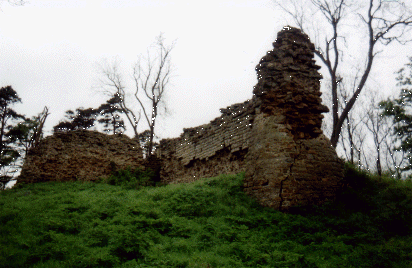Kilton Castle
|

|
|
Kilton Castle, now a mouldering ruin, stands on the crest of a knoll, whose base is laved by a rapid mountain torrent. It exhibits fine specimens of Norman architecture, and is supposed to have been built by Robert de Brus, about the same period as Skelton Castle, viz., the reign of King Stephen. As a fortress, it must have proved impregnable previous to the introduction of artillery; being placed on a high jutting eminence, surrounded by steep precipices, except to the west, where the ditches, foss, inner vallum, and traces of the barbican gate are distinctly observable. The summit of the promontory, 300 feet long and 60 broad, terminating in a narrow projecting ridge, is guarded by strong walls, still remaining. The entrance to the castle from the west is clearly indicated by an ancient road, tolerably perfect, although a portion has been torn up, the large stones being heaped up as we approached. The barbican, ramparts, and other outworks have disappeared; but the position of the great entrance gate may be easily traced, defended by deep ditches, one of which extends 100 feet in length, and measures 26 feet across. It is to be lamented that this noble ruin is not guarded with greater vigilance * Large portions of the stone facings have been hacked, hewed, and violently wrenched from the cement, by barbarians in the neighbourhood, for the purpose of repairing walls, and building byres, barns, and pigstyes. Still, at the western extremity, we trace the grand banquetting hall, 60 feet long by 59 broad. You gaze on the huge eastern watch tower, with its impenetrable walls, its small iron-barred windows, its narrow merlons, with chinks and gillots, where the keen bowmen peered on the advancing foe, or dealt out death on the enemies of their chief. Altogether, Kilton Castle must have proved the most powerful baronial fortress in Cleveland, and during the comparatively harmless days of crossbows, broad swords, and battle-axes, quite impregnable.
Kilton Castle does not appear to have played any conspicuous part in the great stirring events of medieval history. It was the chief seat of the Thweng Family, and here was born, in 1279, Lucia, the fair but frail daughter of Lord Robt de Thweng. Lucia married Robert de Everingham. |